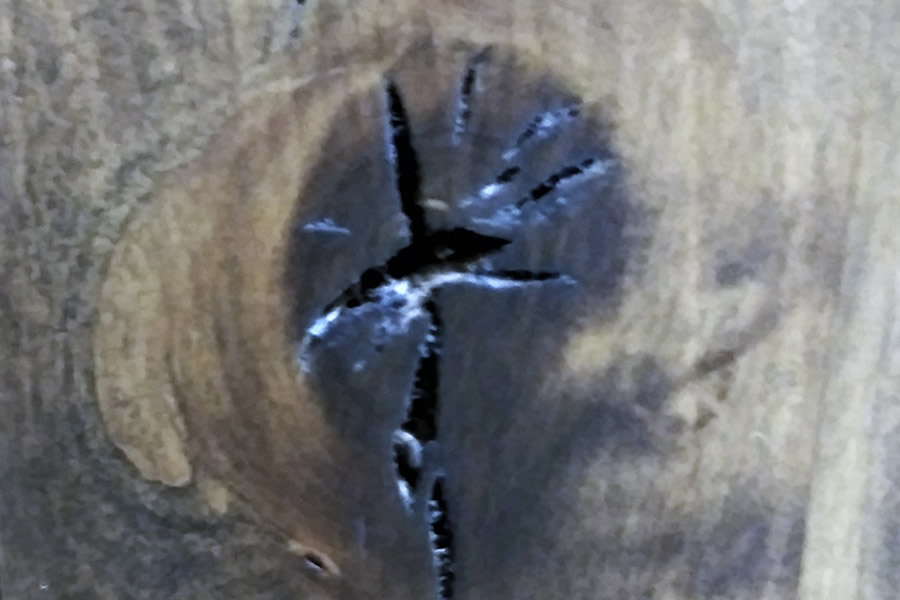
Seeing With The Eyes of Faith
by Larry Fraher, Ph.D | 05/18/2023 | Images of FaithSaint Benedict, in the prologue for his Rule, admonishes his monks to “Listen… with the ear of your heart.” Christians in the world today are called, as we were at the time of St. Benedict, to not only listen with the ear of the heart, but also to see with the eyes of our hearts.
A few weeks ago, I was walking into the church classroom. From the corner of my eye, I noticed what looked like a cross in the wooden door. Upon further inspection, not only a cross was visible, but, indeed, what appeared as a crucifix. Many who also saw the image stated that they could see, in the dark shape behind the cracks in the wood, what appears as the form of a child in an ultrasound. One person noticed the five dashes and remarked about the five wounds of Christ. This “accidental image,” is a series of cracks in a wooden door. Seen with the eye of the heart, however, it appears as a crucifix. The experience reminded me of a deeper call and need in our Catholic culture and society.
We are in danger of losing a specifically Catholic worldview, and with it, a Catholic imagination. One of the main characteristics of Catholic understanding has always been the sacramental worldview. This is knowledge that, because Jesus Christ became a part of this world as a human person, God’s presence is mediated through the physical realities of the world. Certainly we experience these mediations in the seven Sacraments of the Church. Water is the means through which a person is united to the death and resurrection of Christ and made a Christian in Baptism. Oil is the seal upon the forehead that animates our Baptism and empowers us, through the reception of the Holy Spirit in Confirmation, to move into service in the world. Bread and wine make Christ’s body and blood present to us: food and drink that we consume so that we become life-giving nourishment and invigorating power coursing through the veins of humanity. The healing touch of God’s mercy is known via human touch and words in the Sacraments of Reconciliation and Anointing. The total gift of one’s life offered in Matrimony and Holy Orders helps us to see and know the power of Christ’s own gift of self, mirrored to us in those who are married and in the lives of our priests.
Further, there are prayers and devotions that help us to have a greater sense of God’s presence but are not Sacraments: the Stations of the Cross, the Rosary, and the privilege of Adoration of the Blessed Sacrament (naming only a few). Each can help us to build a certain vision and understanding of our faith that allows us to see, within this world, the presence and action of God. These mediations are also able to be known in the events of our lives. They are lower-case “s” sacraments: the grace of God understood in the experiences of a newborn child; His presence known in the intimacy shared with a close friend; the power of God felt in a beautiful sunrise or sunset; or even being reminded of his saving works through a crack in the wood on a classroom door. We are called to the faith-filled vision that allows us to proclaim, with the words of the letter to the Colossians, “all things were created through Him (Christ) and for Him.” (1:16)
On this Feast of Ascension, we celebrate the embrace of the things of this world being brought into the very life and being of God. Jesus Christ, fully human, ascends into Heaven. If this is a reality, then his presence throughout all creation must be available to us. The point here is not to proclaim something miraculous happening to the door of the church classroom. The goal of this small piece of writing is to encourage each one who reads it to allow the Catholic sacramental vision to flood into the heart. It is an encouragement to become so familiar with the things and gifts of faith that, wherever we may look, we, like the apostles, stand in awe of the presence of God. This may just lead us to begin to see things that no longer appear as “accidental images” of faith, but instead become moments of grace and comfort in our daily walk with Christ. Like our Benedictine ancestors in faith, we are called to both listen with the ears and to see with the eyes of our hearts.
BACK TO LIST BACK